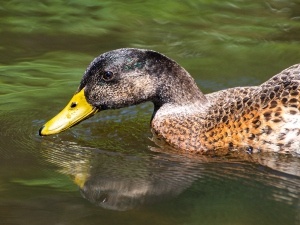
We all expect duck bills to have a distinct bright yellow color, but duck bills can range in color from a drab olive green or a bright raincoat yellow to orange, this is normal.
What isn’t so normal is the duck’s beak suddenly changing color, if you’re wondering why this happens then this article will be of help to you. Read on to figure out why this happens.
Table of Contents
Duck bill color change:
Any change in your bird’s appearance, including the appearance of its bill, should make you wonder what is going on. Here are the possible reasons why your duck’s bill suddenly has a color change:
Bruising:
All animals can fight with each other, even mild-mannered ducks can fight each other. These fights may be minor or the fights may be more serious.
The more serious fight can cause bruising, bruising may be the reason why your bird’s bill looks like it is changing in color.
Ducks can fight over a variety of things including resources like food.
Male ducks can fight to see who is the more dominant duck and who thus earns the right to mate with a female. Birds may also fight as a way of assessing who goes where in the pecking order.
What to do:
You can try stopping the fighting but if the reason behind the fight is to figure out who gets the opportunity to mate with a female, or if the fight is to determine who ranks where in the pecking order, then you can’t do anything about this.
In fact, you shouldn’t do anything about this, fighting, in this case, is natural selection playing out and it is advised that you let nature take its course.
You can however remove a duck if it starts bleeding or becomes seriously injured. Isolate the injured bird, treat its injuries and give it its own food and water
If the birds are fighting over food then you would have to reassess whether you are giving the birds enough food to where every duck is satisfied and eating its fill.
Peeling:
A duck beak is made out of keratin, which is the same material that fingernails are made out of. And just as with fingernails, new keratin is constantly being made to grow the beak.
This process can cause peeling and it can cause a color change in your duck’s bill, your bird’s bill may change in color in the peeling areas changing from yellow to orange or even green
The duck removes this old keratin by scratching its beak against rough surfaces.
What to do:
The removal of old keratin from your bird’s beak is normal but you can help the bird through this process.
If you don’t have rough surfaces that the bird can use to rub its beak against and remove the old keratin then you’d need to add some items with rough surfaces to your property and give birds access to it.
The bird’s beak should go back to being smooth and get back to its regular color once the bird starts rubbing its beak against the surfaces.
Melanin:
If your ducks have started laying, and their bills and or legs have started developing black spots, then what you’re seeing is a pigment that was already under the bird’s skin.
Ducks have melanin just as humans do, melanin is the dark pigment that darkens skin, hair, and irises. These birds also have a pigment called xanthophyll which is a yellow pigment that covers the melanin skin pigment.
When ducks have enough xanthophyll in their bodies their bills remain bright yellow, but when their bodies don’t have enough of this pigment then the melanin starts showing and the bird develops dark spots on its bill.
Low levels of xanthophyll are caused by egg laying. When eggs are produced the yolk absorbers the xanthophyll into itself to help give it a bright yellow color.
If the bird doesn’t eat more xanthophyll-rich foods than the yolk absorbs then the dark spots will develop.
What to do:
This isn’t something to worry about but if you want your duck’s bill to go back to being bright yellow, and not spotty, then you can simply feed the bird more xanthophyll-rich foods.
Xanthophyll-rich foods include corn, alfalfa, green plants, and egg yolks. The bird’s bill will go back to normal once the xanthophyll levels in the bird’s body are replenished.
Age:
A duck’s appearance changes with age. The color of the bird’s feathers changes with age and so does the color of its bill. One type of duck, whose bill will change with age, are Welsh Harlequins.
The bills of female Harlequins will start off being light and the bills of male Harlequins will be grey but once the birds grow older both the female and male Harlequin’s bills will turn grey.
If you’re raising a Harlequin duck, and you notice that your duck’s bill is going grey, then this is why.
What to do:
There isn’t anything you need to do in this situation and you don’t have to worry about your ducks, this is normal and natural for these types of birds.
However, if the change in bill color comes with signs of distress or a negative change in behavior from your bird then you would need to take your bird to the vet to be examined.
FAQ:
What does an unhealthy beak look like?
A change in beak color may or may not be a sign that your duck’s beak is healthy.
Other signs of an unhealthy duck’s beak include cracks, flakiness, overgrowth, or peeling at the beak
If you enjoyed this article then you may also be interested in other chicken related articles. Here are some articles that you may be interested in: Duck Breathing Fast, Why Do Ducks Change Colour?, Duck Sneezing Treatment, Duck Breathing Loud, Duck Breathing Heavy

